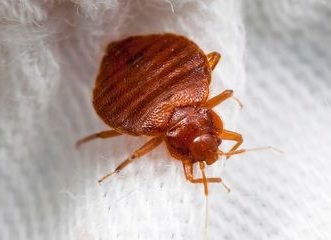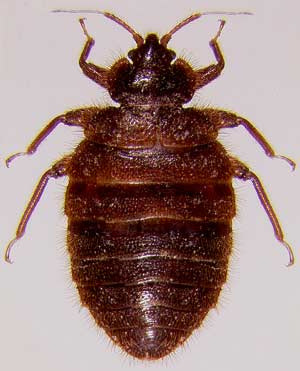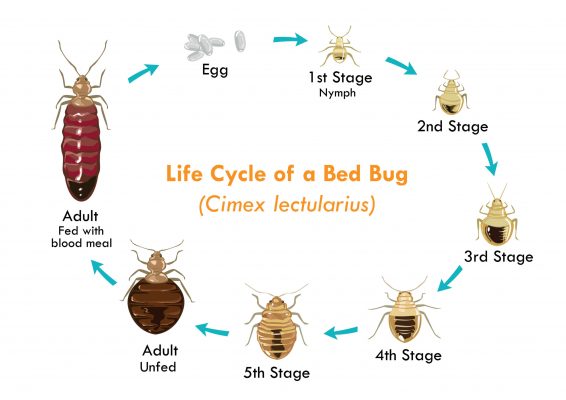Bed bugs are one of the worst pests you can have inside your home. They bite you, leave you itching, reproduce quickly, and invade your most personal space.
But are you sure you have bed bugs, or do you have bat bugs? Unfortunately, differentiating between bed bugs and bat bugs is complex.
Don’t worry. This post will teach you how to tell the difference between bed bugs and bat bugs, including how to get rid of them.
Let’s get started.
What Do Bed Bugs Look Like?

Bed bugs are small, oval-shaped insects. They are about 3/16 inches or 4-5mm. This is around the length of a short grain of rice.
Bed bugs are typically light brown or beige. They can become dark brown around their abdomen after eating. This is due to the blood that you can see through their exoskeleton.
Bed bugs have six legs. Four legs are backward-facing while two legs are forward-facing.
What Do Bat Bugs Look Like?

Bat bugs look very similar to bed bugs. They are both small, oval insects with six legs. They also tend to have a more pointed end to their abdomen.
Bat bugs measure around 6-7 mm round, which is slightly larger than a bed bug.
They are a dark brown or mahogany color. While they do get darker when they eat, the color difference is quite hard to notice since they are already dark brown.
What’s The Difference Between Bat Bugs and Bed Bugs in Appearance?
Bed bugs and bat bugs look very similar at first glance. But, if you know what to look for, there are some key differences that you can use to differentiate them.
Below are some of the differences you can use to tell bed bugs and bat bugs apart.
- Size: Bed bugs are slightly smaller than Bat Bugs
- Shape: Both bed bugs and bat bugs are oval, but bat bugs have a narrower and more pointed abdomen.
- Color: Bed bugs are lighter in color than bat bugs. Bat bugs are light brown or beige, while bat bugs are dark brown or mahogany.
- Hairs: Bed bugs don’t have any hairs, while Bat bugs have small hairs on their pronotum (the small area between their head and abdomen.
- Pronotum: Bed bugs have a deeply concave pronotum, while bat bugs have a slight concave (nearly straight) pronotum
- Antenna: Bed bugs have thinner antennae than bat bugs.
Where Can you Find Bed Bugs and Bat Bugs?
Bed bugs feed on humans. As a result, you can typically find them near the sleeping area or where humans frequent and stay the most.
In most cases, you can find bed bugs in bedrooms. But depending on the situation, they can also be found inside living rooms, couches, seating areas, dining rooms, and inside cars.
Bat bugs like bed bugs can be found near their host. For bat bugs, this means you can find them tear their roosting areas.
This typically means that you can find bat bugs in attics, chimneys, trees, roofs, or other walls/ ceiling voids inside the home.
https://www.youtube.com/watch?v=z7GVoJycsgg
What Do Bat Bugs and Bed Bugs Eat?
Bed bugs and bat bugs both feed on blood—the only difference their preferred host.
Bed bugs prefer humans, while bat bugs prefer bats. Don’t let this fool you; both bat bugs and bed bugs will resort to other hosts if necessary.
For example, bed bugs will resort to feeding on bats, dogs, cats, or birds inside the home if they can’t feed on humans for prolonged periods.
Likewise, bat bugs will feed on humans or other mammals if their original host is no longer available.
Both bat bugs and bed bugs have in common that they require the blood from their preferred host to reproduce. Without the blood from their host, the population will eventually die out.
Unfortunately, bed bugs can live for more than six months without eating, which means it can take longer than one year for all bed bugs to die of starvation or naturally.
Can Bed bugs and Bat Bugs Cause diseases?
Bed bugs don’t spread any diseases. Studies and tests show that bed bugs don’t transmit any diseases. They can’t spread diseases from one human to another.
Studies attempting to transmit both hepatitis B and HIV were unsuccessful through bites or contact with feces.
Bat bugs, on the other hand, are capable of transmitting diseases, although it’s unlikely.
For bat bugs to transmit a disease, they must first feed on a bat that has a transmittable disease.
A study conducted on Thailand bat bugs found that they were able to transmit encephalitis virus to workers mining for bat guano.
This can pose a great danger to humans that come in contact with bat bugs.
It is important to note that not all bat viruses are transmittable to humans. Those that are transmittable are known as zoonotic viruses.
There are over 60 zoonotic diseases, but there is no research on which diseases can be transferred from bats to humans.
Where are Bed Bugs and Bats Found?
Bed bugs are found across the U.S. There have been reports of bed bugs in every state in the United States. They are more common in states with larger populations or states that are less rural and more urban.
Bat bugs, on the other hand, are only found where bats are present. But since bats are versatile mammals, they can be found in every state in the U.S.
Bats bugs are less common in states with harsh conditions such as high heat, heavy rain, or snow.
The biggest difference between bat bugs and bed bugs is that bed bugs are prominent in populated areas, while bat bugs are more common in rural, less populated areas where bats thrive.
What Causes Bat Bugs and Bed Bugs?
Bed bugs are typically spread from one infestation to another. They typically enter homes by hitchhiking on objects.
Some common objects that bed bugs hitchhike on include:
- Used furniture
- Backpacks
- Books
- Clothes
- Grocery bags
- Cars
Bat bugs, on the other hand, are caused by bats. If there are bats inside your home or near your home, it is a sign that you have a bat infestation or had a bat infestation recently.
What Do Bed Bug and Bat Bugs Bites Look Like?
Both bat bugs and bed bugs bite humans and other mammals.
Unfortunately, the reports and information on bat bugs are not as extensive as bed bug bites.
It’s expected that bed bugs and bat bug bites follow the same characteristics and tendencies.
One difference that has been reported among people is that bat bug bites are more painful than bed bug bites.
- Bed bug and Bat bug bites look like welts. They come in clusters and occur in a line or a zig-zag pattern.
- Both bites are itchy and uncomfortable.
- They bite any exposed skin, including arms, legs, back, torso.
- They rarely bite on the neck and face unless you’re wearing pants and long sleeves.
- Bed bugs and bat bugs feed approximately once every three to ten days.
- Both bugs return to their hiding spot after biting on their host.
Bat bugs vs. bed bug lifecycle

Both bat bugs and bed bugs follow the same lifecycle.
Bed bugs and bat bugs go through seven stages of development.
The first stage is egg, followed by five different nymph stages, and finally, the adult stage.
During the nymph stages, they progressively grow larger.
Nymphs must eat at least once to reach the next phase of development.
Bed bugs eggs take around five to six weeks for bud bugs to reach adulthood.
Frequently Asked Questions (FAQ)
How big are bat bugs and bed bugs?
Bed bugs are slightly smaller than bat bugs. Bed bugs are about 3/16 inch or 4-5 mm, while bat bugs are ¼ inch or 6-7 mm.
This difference is hard to tell in person. This is the reason that size is not the best way to tell bat bugs and bed bugs apart.
Do bed bugs or bat bugs have hair?
Bed bugs and bat bugs both have small hairs around their body. These hairs are so small that they are nearly impossible to see with human eyes.
These hairs are more noticeable on bat bugs, specifically around the pronotum. But they are still hard to see if you are not using a magnifying glass.
How to tell bud bugs from a bat bug?
There are several key features you can use to tell bed bugs from bat bugs. Unfortunately, to differentiate between bed bugs and bat bugs, you are going to need a magnifying glass.
The key characteristics to distinguish bed bugs from bat bugs are listed below:
- Bat bugs have noticeable hairs around their pronotum, while bed bugs don’t
- Bat bugs are darker in color than bed bugs
- Bat bugs have a flat or slightly concave pronotum, while bed bugs have a deeply concave pronotum.
- Bat bugs are larger than bed bugs
- Bat bugs have a narrower abdomen than bed bugs
Can Bat Bugs Reproduce Without Bats?
Bat bugs can’t reproduce without bats. There are specific proteins inside the blood of bats that they need to reproduce.
Bat bugs can survive off the blood of other mammals, including humans. Without feeding on bats, the population will eventually die out because no new bugs will be produced.
Can Bed Bugs Reproduce Without Humans?
Bed bugs can’t reproduce without humans, just like bat bugs can’t reproduce without bats. Bed bugs require specific proteins inside human blood to reproduce.
While they can feed on other mammals such as dogs, cats, and birds, they can’t reproduce with their blood.
Without humans, bed bugs will eventually die out. But, since bed bugs can survive for more than six months without food, it can take as long as one year for the entire population to die out.
What Animals look Like Bed Bugs and Bat Bugs?
Some animals and insects are often confused with bed bugs and bat bugs.
- Swallow bugs
- Poultry bugs
- Chimney swift bugs
- Tropical bed bugs
- Carpet Beetles
- Dust Mites
- Ticks
- Fleas
- Spider Beetles
- Booklice
- German Cockroach Nymphs
- Headlice
- Kissing Bugs
- Stink Bug
